William E. Davis, Jr.
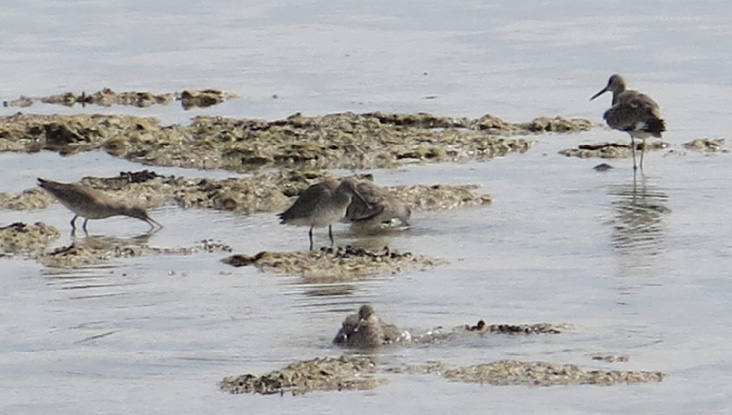
Figure 1. Two Willets are bathing, one is fluffing its feathers and the other three are between preening bouts. All photographs by the author.
During March and April 2020, my wife and I were in a rental home at 1455 Long Beach Drive, Big Pine Key, Florida, where I was able to record and photograph the bathing habits of Willets (Tringa semipalmata) on numerous occasions. The house was on the ocean side and provided an opportunity to watch shorebird behavior in the shallow water and beach wrack. I had reported on a group of five Willets, in a flock of about 150, group bathing at the Ding Darling National Wildlife Refuge on Sanibel Island, Florida, but did not describe or photograph the behavior in detail (Davis 2016). Our stay on Big Pine Key offered an opportunity to more thoroughly examine and document the bathing practices of Willets. I recorded my observations in a journal and, when possible, photographed these events. What follows are descriptions taken from my journal notes of the bathing events I witnessed.
On March 26, 2020, at 4:00 pm, I was watching White Ibises (Eudocimus albus) foraging in the back of our house and at 4:55 p.m. a single White Ibis began bathing in a pool past a small mangrove. Seven minutes later a Willet approached the bathing Ibis and began bathing itself. The power of suggestion in birds to join a bathing bird seems remarkable. On March 29 at 5:06 pm, I watched a bathing Willet duck its head under water, then fluff and flap its partially opened wings, its body partially immersed. It bathed for six minutes and then stood and preened for nine minutes before flying to shore where it preened for an additional five minutes. A second Willet also bathed. The following day at 4:55 pm, a pair of Willets preened, and one scratched its chin. One bird put its head completely under the water and brought it up splashing water onto its back and closed wings; then it bathed, submerging most of its body and fluffing and flapping its partially opened wings. It preened again from 4:59 to 5:06 pm and then walked away. The second Willet also bathed and preened.
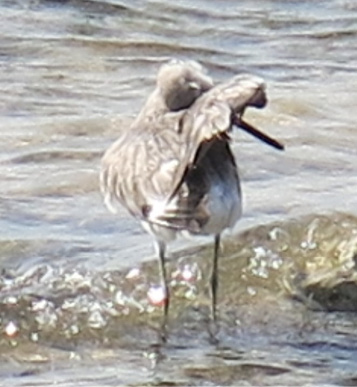
Figure 2. The Willet frequently rubs its bill and head against a partially raised wing.
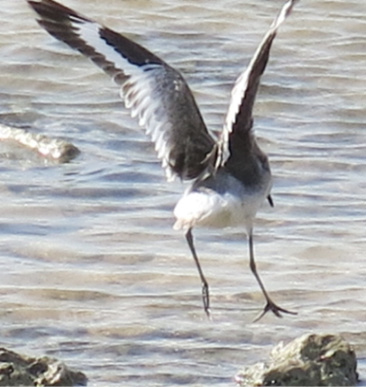
Figure 3. The Willet is off the ground in a preening jump.
On April 11 at 3:30 pm, I noticed a flock of six Willets bathing together (Figure 1). They partially submerged their bodies and flapped their wings. Occasionally, one would put its head under water and bring it up with a shake, tossing water onto its back. After multiple bathing bouts the Willets stood, fluffed their body feathers and raised their wings—a rather attractive sight with flashing black and white. They always dipped their bills in the water before each preening event. Chin-scratching was common. One Willet was still bathing when a Ruddy Turnstone (Arenaria interpres) joined the group and began to bathe. The tendency toward group bathing in shorebirds appears to be profound. Several Willets were still preening at 4:30 pm, when I ceased observation.
On April 13 at 9:55 am I noticed a Willet bathing. With its body mostly out of the water it dipped its head under water, then flipped its head up and to the side, tossing water onto its back with a much-repeated rocking motion. Then it stood and preened with some fluffing and shaking its tail from side to side. It frequently pushed its head and neck against a partially elevated wing (Figure 2). Occasionally, it raised its wings and sometimes jumped or flew up a few inches with wings extended upward (Figure 3). This bathing episode lacked the wing-beating against the water that characterized earlier Willet bathing episodes, although that may have occurred before I noticed the bathing bird. It was the only bathing Willet that I observed in the morning.
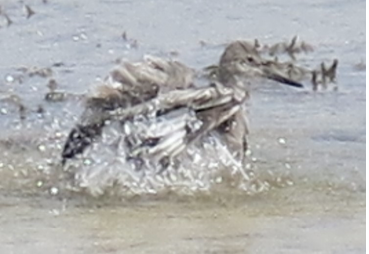
Figure 4. The bathing Willet splashes furiously with its wings.
On April 15 at 6:20 pm, I noticed a Willet bathing. It splashed with flapping wings, did the dipping routine that I had seen previously, and at one point was almost completely submerged. Eventually, it went into a protracted preening session that lasted until 6:42 pm. On April 19 at 6:05 pm, a Willet dipped its bill and head under the water, rocked from front to back, and fluffed as it bathed. It then raised its wing and semi-flew about five feet to shallower water and stood preening. At 6:10 pm, it flew away.
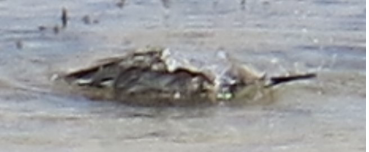
Figure 5. The Willet is nearly submerged. It has dipped its head and is splashing water onto its back.
On April 24 at 3:35 pm, I noticed a Willet bathing in the shallows and photographed the bathing and subsequent preening. The Willet would dip its head and bill under water in a rocking motion, then settle down partially submerged and splash with its wings (Figures 4 and 5). It repeated this behavior a dozen times or more. It then raised its wings and hopped ashore and began to preen, always starting a preening bout by dipping its bill in the water. It preened its back and breast, and under its wings (Figure 6). It periodically shook and fluffed its body feathers and scratched its chin.
On April 18 at 5:03 pm, four Whimbrels flew in and alighted in the shallow water near two Willets. The Willets walked off but one stopped about 10 feet from the Whimbrels. At 5:30 pm, one of the Whimbrels began to bathe. The other Whimbrels preened. The nearby Willet began to bath at 5:37 pm, apparently stimulated by the nearby Whimbrels bathing or preening.
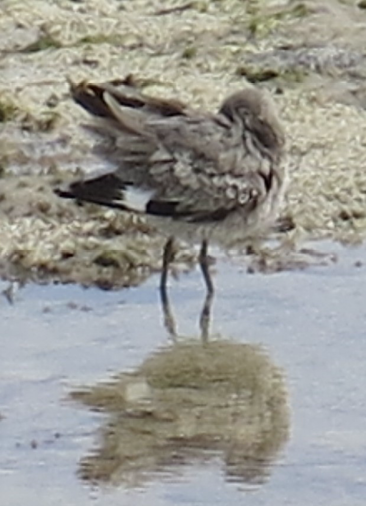
Figure 6. The Willet preens its back.
The Birds of the World’s Willet account (Lowther et al. 2020) reports “no information” on bathing or preening. I searched Google and found a video of Willets bathing, and a number of photographs but no references to it in the scientific literature, and no references to group bathing by Willets. On the six occasions that I observed a single Willet bathing there were no other Willets in sight, and in two of those cases the Willet was bathing with another species. On the three occasions when there was more than one Willet present, all of the Willets bathed. It appears that Willets will bathe when solitary but that if there are birds nearby, they will bathe in a group. All but one of the bathing episodes occurred in the afternoon, usually late afternoon, suggesting that bathing for Willets is generally an end-of-day procedure. The nearby Willet that watched the bathing Whimbrel and then proceeded to bathe offers another example of the apparent power of suggestion, and the resultant tendency toward group bathing.
Literature Cited
- Davis, W. E. Jr. 2016. Shorebird Behavior on their Wintering Grounds. Bird Observer 44: 266-269.
- Lowther, P. E., H. D. Douglas, III, and C. L. Gratyto-Trevor. 2020. Willet (Tringa semipalmata), Version 1.0. In Birds of the World (A. F. Poole and F. B. Gill, eds.). Cornell Lab of Ornithology, Ithaca, New York. . https://doi.org/10.2173/bow.willet1.01 Accessed June 4, 2021.